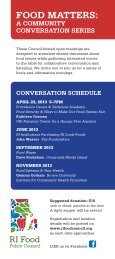Promising Strategies to Improve Access to Fresh, Healthy Food and ...
Promising Strategies to Improve Access to Fresh, Healthy Food and ...
Promising Strategies to Improve Access to Fresh, Healthy Food and ...
Create successful ePaper yourself
Turn your PDF publications into a flip-book with our unique Google optimized e-Paper software.
PolicyLinkWhy <strong>Access</strong> MattersHealth BenefitsResearch has demonstrated that when lowincomeindividuals <strong>and</strong> people of color haveaccess <strong>to</strong> local s<strong>to</strong>res that sell a wide varietyof high-quality, nutritious foods at affordableprices, they make healthier choices about theirdiets, have better health outcomes, <strong>and</strong> benefitfrom improved local economic development. 37Better <strong>Access</strong> Contributes <strong>to</strong>Healthier EatingIn both urban <strong>and</strong> rural areas, people withlimited access <strong>to</strong> supermarkets or other s<strong>to</strong>resselling healthy food near their homes areless likely <strong>to</strong> have a healthy diet than thosewith better access—<strong>and</strong> people with betteraccess have better diets. For example:• Among adults in Baltimore, New York City, <strong>and</strong>North Carolina, those with no supermarketswithin a mile of their homes are 25 <strong>to</strong> 46percent less likely <strong>to</strong> have a healthy diet thanthose with the most supermarkets near theirhomes; this remained true after adjustment forage, sex, race/ethnicity, <strong>and</strong> socioeconomicstatus. 38• In rural Mississippi, adults living in “fooddesert” counties are 23 percent less likely <strong>to</strong>consume the recommended amount of fruits<strong>and</strong> vegetables than those in other counties,controlling for age, sex, race, <strong>and</strong> education. 39• African Americans living in neighborhoods withat least one supermarket are more likely <strong>to</strong>meet dietary guidelines for fruit <strong>and</strong> vegetableconsumption <strong>and</strong> fat intake than AfricanAmericans living in neighborhoods withoutsupermarkets. 40• One study found that fruit <strong>and</strong> vegetableconsumption increases 32 percent forAfrican Americans with each additionallocal supermarket, <strong>and</strong> 11 percent for whiteAmericans. 41• In New Orleans, proximity <strong>to</strong> s<strong>to</strong>res s<strong>to</strong>ckingmore fresh produce is associated with highervegetable consumption. Each additional meterof shelf space devoted <strong>to</strong> fresh vegetables isassociated with an additional 0.35 serving ofvegetables per day. 42Better <strong>Access</strong> Contributes <strong>to</strong>Lower Rates of Obesity <strong>and</strong>Diet-Related DiseaseA number of studies have found that thepresence of supermarkets corresponds withlower rates of diet-related disease includingobesity <strong>and</strong> diabetes. For example:• Increased availability of chain supermarkets isassociated with lower rates of being overweightamong teens. 43• An Indiana study found that children wholived near a supermarket are less likely <strong>to</strong> beoverweight. 44• A New York City study found that obesity ratesare lower for people surrounded by more s<strong>to</strong>resselling healthy food relative <strong>to</strong> unhealthy food—<strong>and</strong> that increased density of healthy s<strong>to</strong>resreduces obesity rates. 45• One study found that people living inneighborhoods with supermarkets compared<strong>to</strong> people living in places with access <strong>to</strong> onlysmaller food s<strong>to</strong>res, convenience s<strong>to</strong>res, or both,have lower rates of obesity (21 percent versus<strong>Healthy</strong> <strong>Food</strong>, <strong>Healthy</strong> Communities17



